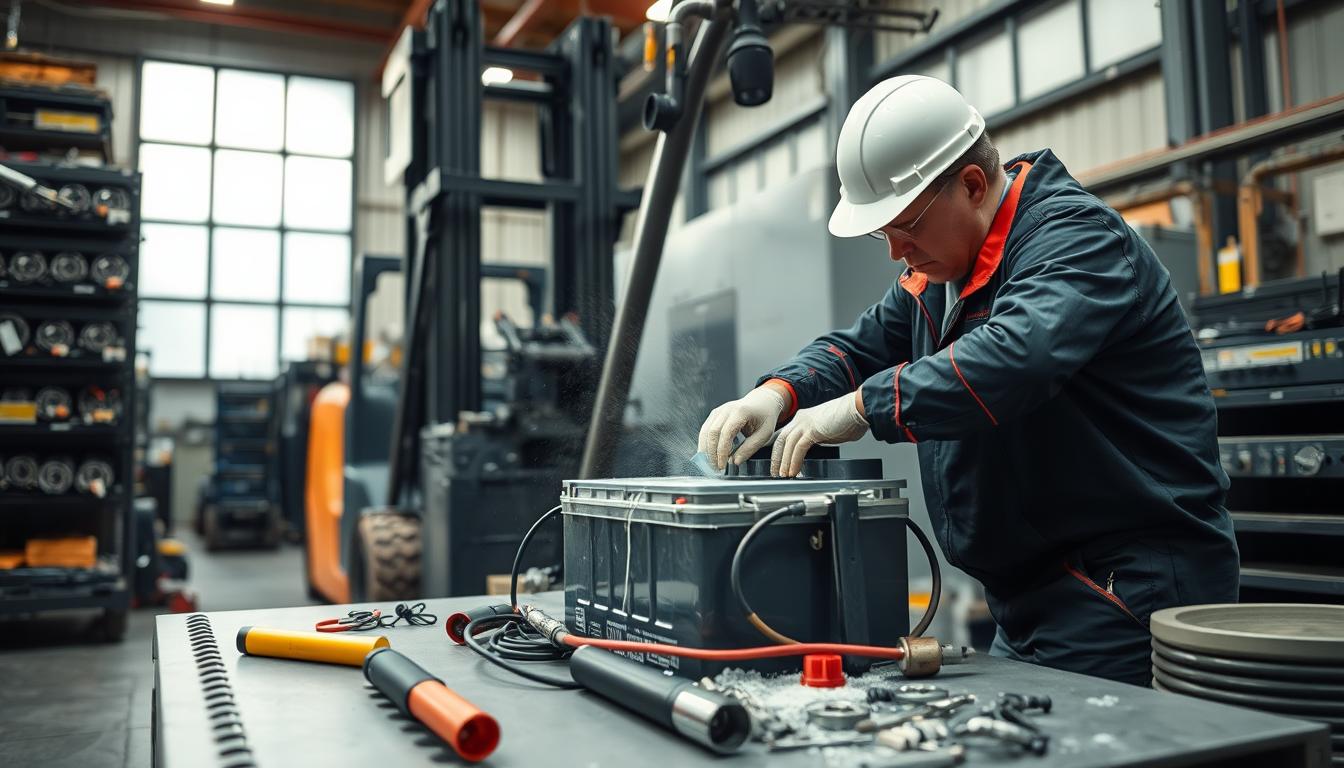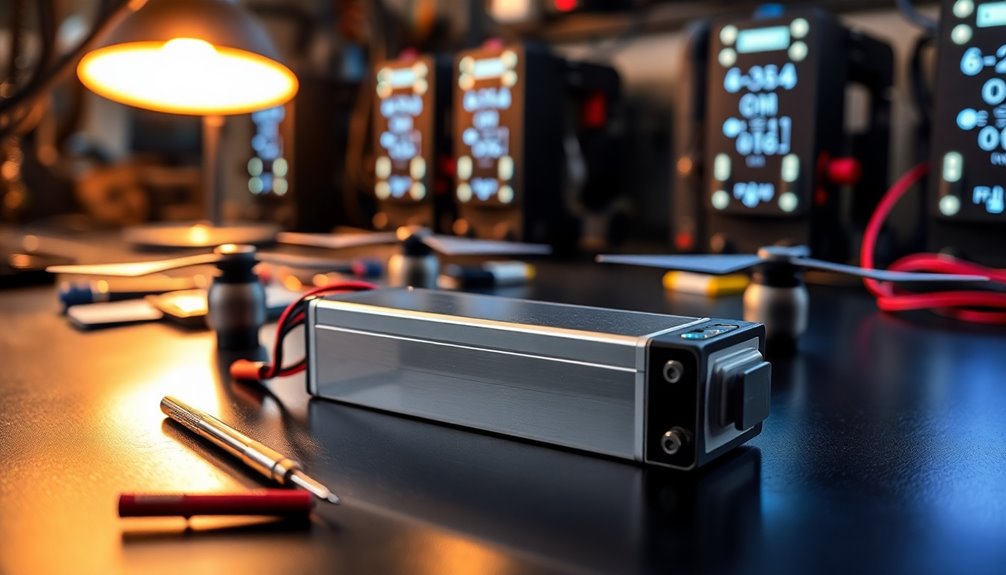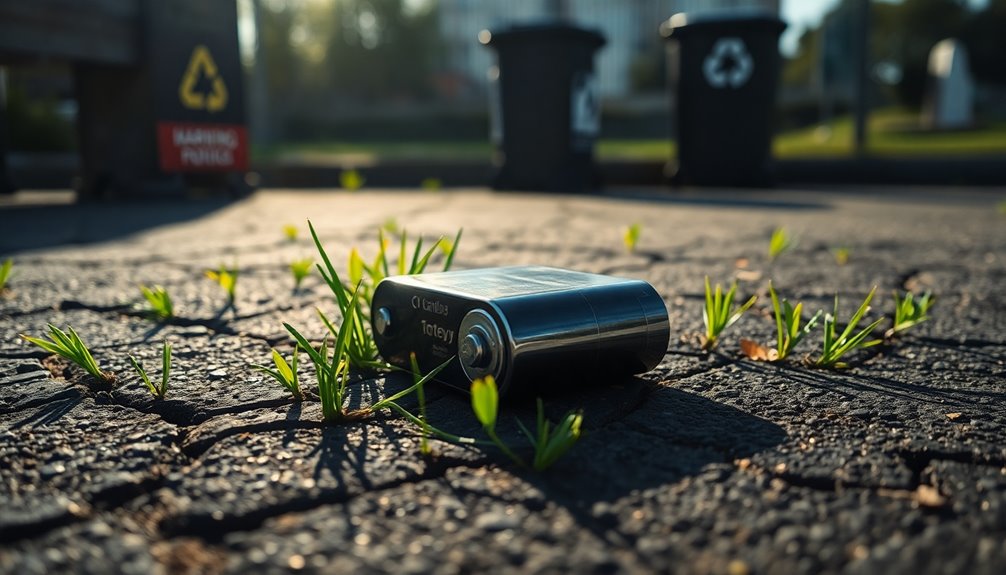Did you know that lead-acid batteries, the most prevalent type used in industrial forklifts, require regular maintenance to ensure safety and efficiency? Forklift batteries can weigh between 2,000 to 5,000 lbs., presenting significant risks, including crushing injuries if not handled properly1. Understanding the importance of forklift battery reconditioning and maintenance is crucial, as proper care can drastically extend both the lifespan of your battery and the overall performance of your forklift.
Your awareness of key practices for forklift battery maintenance can greatly minimize the risk of unexpected battery failures, ultimately enhancing the effectiveness of your operations. Regular inspections, appropriate charging methods, and timely reconditioning are integral to maintaining the health of your forklift batteries. From preventing hazardous chemical burns due to battery acid spills to ensuring proper ventilation while charging, being proactive can help avoid potential accidents and costly downtime.
Key Takeaways
- Lead-acid batteries require regular maintenance for safety and efficiency.
- Regular inspections can prevent dangers such as crushing injuries and chemical burns.
- Proper charging methods and timely reconditioning extend battery lifespan.
- Ventilation is crucial to prevent flammable gas buildup during charging.
- Being proactive in maintenance ensures optimal forklift performance and reliability.
Understanding Forklift Batteries
Forklift batteries are essential components for efficient operations in warehouses and industrial settings. To ensure you maximize their performance and longevity, understanding the various types of forklift batteries, basic battery terminology, and the importance of battery maintenance is crucial. This section explores these dimensions in detail.
Types of Forklift Batteries
There are primarily three types of forklift batteries: lead-acid, lithium-ion, and Absorbed Glass Mat (AGM) batteries. Lead-acid batteries are the most common, often lasting five or more years with proper watering and maintenance2. Lithium-ion batteries, being smaller and requiring additional counterweights for balance, are gaining popularity due to their low maintenance and safety features3. AGM batteries are preferred for their efficiency as they charge up to five times faster than lead-acid batteries, significantly reducing downtime3.
Basic Battery Terminology
Familiarity with basic battery terminology enhances your ability to manage and maintain forklift batteries. Key terms include “sulfation,” which refers to the buildup of lead sulfate crystals that can degrade battery performance, and “hydrometer,” a tool used to measure the specific gravity of the electrolyte in lead-acid batteries4. Understanding these terms aids in effective communication about battery conditions and troubleshooting issues.
Importance of Battery Maintenance
The importance of battery maintenance cannot be overstated. Regular inspections, cleaning, and watering are essential to ensure optimal performance2. For lead-acid batteries, maintaining electrolyte levels with deionized water is crucial, as improper levels can lead to overheating and increased operational costs4. Monthly specific gravity tests are also necessary to monitor battery health and performance3. Neglecting proper care can result in poor charging capabilities and reduced lifespan of the battery4.
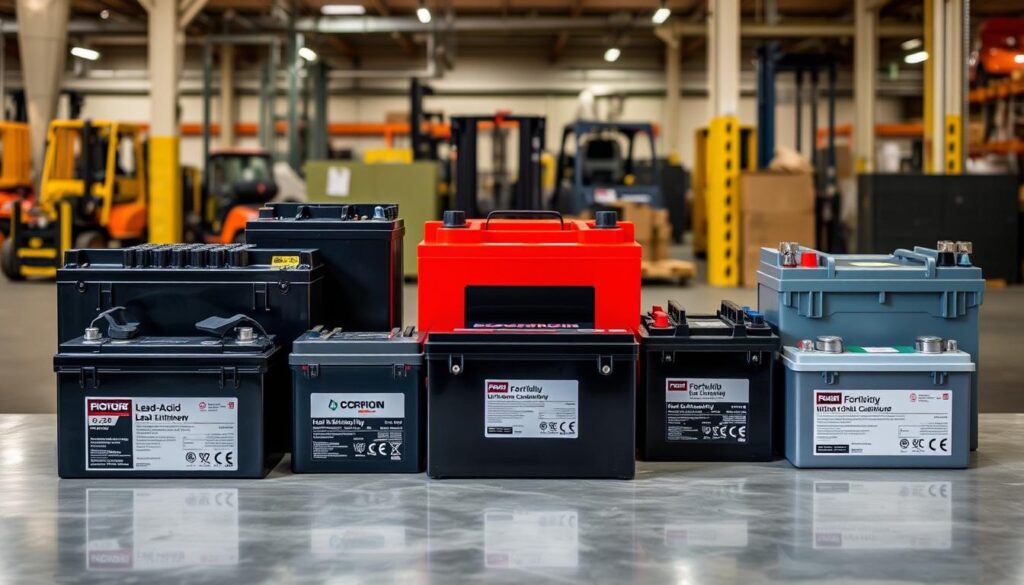
Signs Your Forklift Battery Needs Reconditioning
Recognizing the signs of battery reconditioning is crucial to keep your forklift operating smoothly. If you notice decreased performance indicators, such as a decline in the lifting capacity or slower acceleration, it may be time to take action. Being aware of these issues can save you from costly replacements down the road.
Decreased Performance Indicators
When your forklift battery shows decreased performance indicators, you may experience a shorter run time or difficulties lifting heavy loads. A common symptom is the battery draining very quickly, meaning it is no longer holding a charge adequately. Additionally, diminished or slow performance of electric forklifts indicates a failing battery and often correlates with problems like corrosion on the terminals, which could signal the need for replacement5. Visibility into acid collection outside the battery is another red flag6. Keeping the charge above 20% of total capacity helps optimize battery life and maintain efficiency6.
Charging Issues to Watch For
Charging issues can also be significant indicators of a battery that needs reconditioning. If you observe slow charging, it could signify battery degradation6. Other warning signs include a rotten egg smell during usage, excessive heat, or smoke when charging. These issues not only compromise performance but may also necessitate immediate battery replacement57. Regular cleaning and maintenance of the electrolyte levels are critical in preventing these charging problems from escalating into serious hazards7.
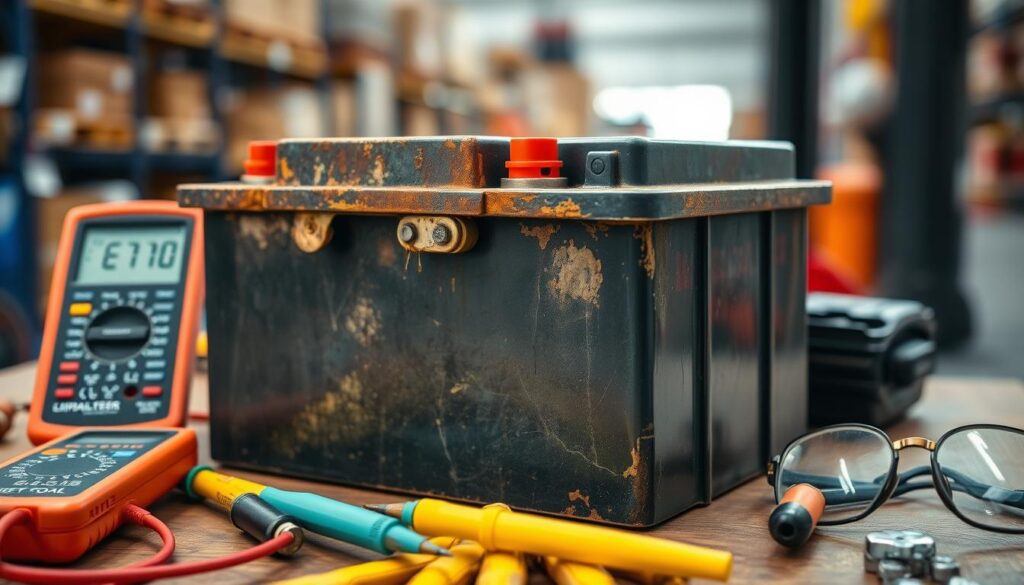
Forklift Battery Reconditioning Process
Reconditioning your forklift battery is a crucial step to maintain its performance and longevity. This process begins with adequate preparation and awareness of the necessary safety precautions during reconditioning. You want to ensure that you have all the right tools and equipment at hand to avoid any complications.
Preparation for Reconditioning
Gathering the right equipment is essential for a successful forklift battery reconditioning process. Here’s what you need:
- Battery Chem™ reconditioning agent
- Protective gear, like gloves and goggles
- A well-ventilated workspace
- Basic tools for cleaning and testing
Once you have the necessary items, assess your battery’s condition to plan your next steps effectively.
Steps to Recondition Your Battery
Follow these steps to recondition your battery:
- Clean the battery terminals and surrounding areas to remove any dirt or corrosion.
- Check electrolyte levels; if low, top them up with distilled water.
- Add 1 cup of Battery Chem™ per cell, with the option to add an additional 1/2 cup if performance is borderline.
- Begin the charging process, which may take up to two weeks to see significant performance improvements.
Users have reported a success rate of approximately 70% when utilizing the Battery Chem™ reconditioning treatment8. By following these steps methodically, you can effectively restore your battery’s functionality.
Safety Precautions to Follow
Safety should always come first. While performing the reconditioning, adhere to the following safety precautions during reconditioning:
- Wear protective gear to safeguard against exposure to battery acid.
- Ensure adequate ventilation to avoid inhaling any harmful gases.
- Have an emergency plan in place, including a means to neutralize spills or accidents.
By implementing these safety measures, you can minimize risks and create a secure environment for performing the forklift battery reconditioning process. Remember, a little preparation goes a long way towards preventing mishaps.
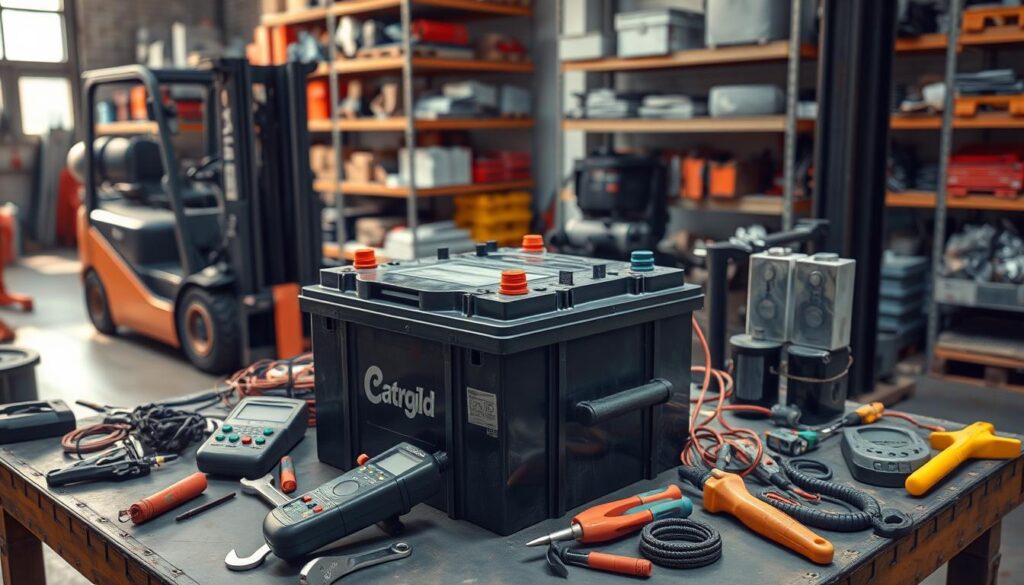
Investing time in understanding the forklift battery reconditioning process can significantly enhance battery life and performance, ensuring you maximize productivity and efficiency in your operations89.
Tools and Equipment for Battery Maintenance
To ensure optimal performance and longevity of your forklift batteries, it’s crucial to have the right tools for battery maintenance. Utilizing appropriate equipment allows you to effectively clean and maintain battery components, thus enhancing overall battery life. Below are some essential tools and equipment that you’ll find beneficial.
Essential Tools for Forklift Batteries
- Hydrometer: Used for checking the specific gravity of battery electrolyte, this tool helps assess the charge level of your batteries.
- Battery Cleaning Supplies: Regular cleaning of battery terminals and cases with industrial battery cleaners prevents corrosion, ensuring better performance over time10.
- Battery Spill Kits: Designed to provide quick cleanup solutions for battery acid spills, they ensure a swift response and proper disposal of spilled acid11.
- Battery Filler Tools: These tools are essential for maintaining the correct electrolyte levels, which is vital for battery health.
- Lifting Equipment: Proper lifting tools are necessary for safe handling of heavy forklift batteries, preventing injuries during maintenance.
Recommended Brands and Models
Choosing the right brands can significantly impact your battery maintenance effectiveness. Consider the following:
| Tool | Brand | Price |
|---|---|---|
| Hydrometer Battery Tester Glass | QuickCable | $3.17 |
| Battery Cleaning Brush | QuickCable | $7.79 |
| Battery Terminal Spreader | QuickCable | $7.25 |
| Battery Filler Bulb | QuickCable | $4.49 – $4.64 |
Using these recommended battery maintenance tools not only promotes safety but also improves efficiency, enabling you to maintain your forklift batteries effectively12.
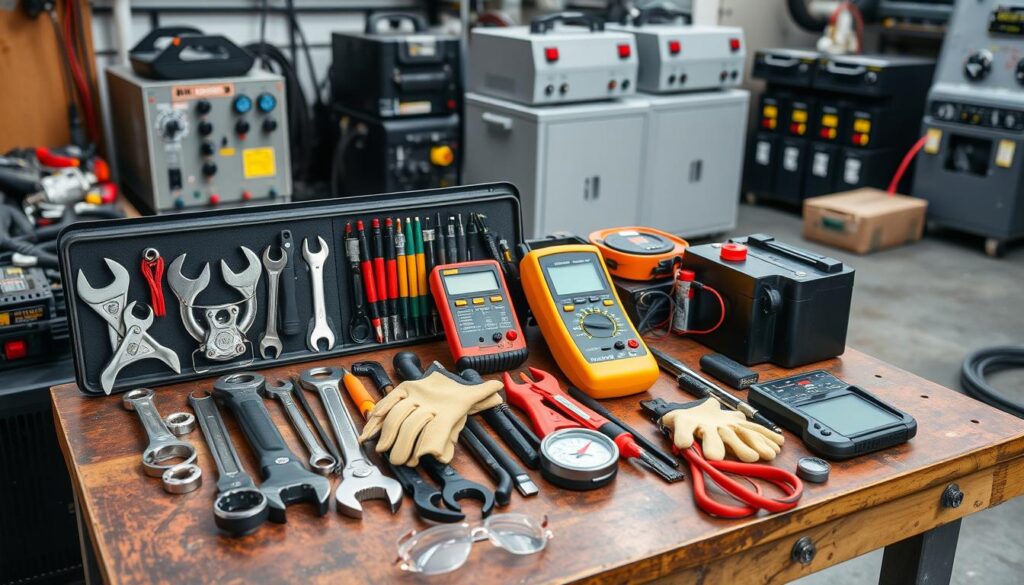
Best Practices for Battery Charging
Adhering to best practices for battery charging is essential to ensure your forklift’s battery operates efficiently and has a prolonged lifespan. Implementing the right strategies can significantly impact battery performance and longevity. Here are some guidelines to follow.
Ideal Charging Frequency
Establishing an ideal charging frequency is vital for maintaining battery health. It is generally recommended to recharge your forklift battery after an eight-hour shift or when discharging beyond 30% capacity. This practice prevents deep discharges, which can drastically reduce the lifespan of the battery13. The Occupational Safety and Health Administration (OSHA) suggests charging lead-acid batteries at 80% depth of discharge to optimize their life expectancy14. Maintaining a consistent schedule and avoiding frequent interruptions will contribute to better battery performance.
How to Maximize Battery Life
Maximizing battery life requires careful attention to charging methods and environmental conditions. Always aim to charge batteries to 100%, ensuring that they cool down appropriately before use, as excessive heat during charging can shorten battery life by half13. For lithium batteries in particular, it is important to charge after each shift to keep operations running smoothly and to avoid complete depletion to prevent accelerated wear15. Regular inspection of batteries for damage and maintaining optimal temperatures, ideally below 113 degrees Fahrenheit, will further enhance battery longevity13. Using compatible chargers tailored to your battery’s specifications is crucial to prevent any damage14. A designated charging area equipped with a fire extinguisher adds an extra layer of safety during the charging process13.

| Charging Practice | Benefits |
|---|---|
| Charge After Each Shift | Prevents unexpected downtime and maintains battery readiness |
| Avoid Deep Discharge | Extends battery lifespan and prevents irreversible damage |
| Maintain Optimal Temperatures | Improves efficiency and prolongs service life |
| Use Compatible Chargers | Minimizes risk of damage and ensures proper charging |
| Regular Inspections | Detects issues early, preventing costly repairs |
Implementing these best practices for battery charging will go a long way in helping you maximize battery life and achieve optimal performance in your forklift operations.131415
Importance of Regular Maintenance Checks
Regular maintenance of forklift batteries is crucial for ensuring their longevity and operational efficiency. This proactive approach can prevent unexpected breakdowns and safeguard against accidents at the workplace. Establishing a thorough maintenance schedule not only complies with regulatory standards but also enhances productivity and safety.
Recommended Maintenance Schedule
A comprehensive maintenance schedule should include daily pre-shift inspections. According to OSHA, these inspections are vital for compliance and safety, helping to identify any issues before they escalate into major problems16. Companies are advised to perform planned maintenance every six weeks or after approximately 250 operating hours. This reduces the likelihood of costly repairs and helps maintain forklift performance16.
Key Components to Inspect
When conducting maintenance checks, there are key battery components to inspect regularly:
- Connectors and cables for corrosion or damage
- The battery case for any signs of wear or cracks
- Fluid levels, ensuring they are within the recommended range
- Overall forklift condition, including safety features and indicator lights
Maintaining these components is essential as it significantly extends the lifespan of forklifts and maintains their resale value1718. Companies maintaining detailed service and inspection records can better prepare for replacements, which enhances overall safety and efficiency17.
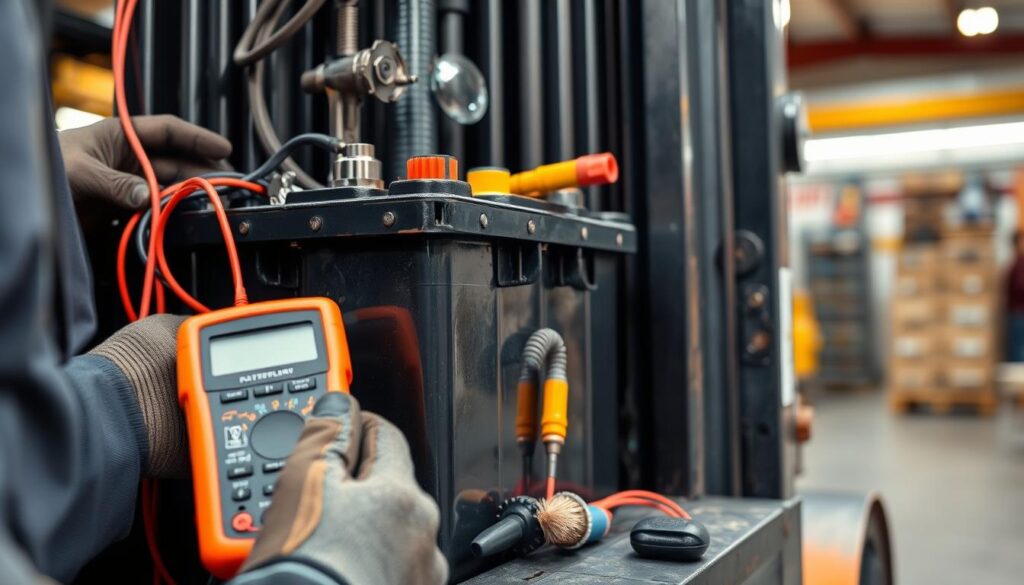
Cleaning Your Forklift Battery
Maintaining your forklift battery through effective cleaning is essential. This practice not only enhances performance but also prevents corrosion that could lead to costly repairs. Implementing safe cleaning techniques ensures both your safety and the longevity of the battery.
Safe Cleaning Techniques
When it comes to cleaning forklift batteries, adhering to proper safety measures is crucial. You should wear protective gear, including gloves and goggles, to shield yourself from any harmful substances. Use a cleaning solution that combines half a pound of baking soda or ammonia, hot water, detergent, and at least a gallon of fresh water for optimal results19. Start the cleaning process by checking the battery vent caps to ensure they are tight and secure before proceeding19.
After applying the cleaning solution, rinse the top of the battery thoroughly with clean, hot water19. In cases where there is a significant buildup of calcium deposits, utilizing a wire battery terminal brush may be necessary for thorough cleaning19.
Cleaning Frequency and Tips
The cleaning frequency for batteries can vary widely. Some forklift batteries may require cleaning every six months, while others may need attention every couple of weeks due to the rapid accumulation of dust, oil, dirt, and debris19. Establishing a routine can significantly enhance performance and prolong battery life, particularly in environments with high levels of contaminants.
Check battery fluid levels every five charge cycles and top off every 10 charges, but only after ensuring the battery is fully charged20. This routine can help maintain the proper electrolyte balance and prolong the battery’s lifespan. Following these battery cleaning techniques and frequency recommendations can result in a more effective and efficient forklift operation.
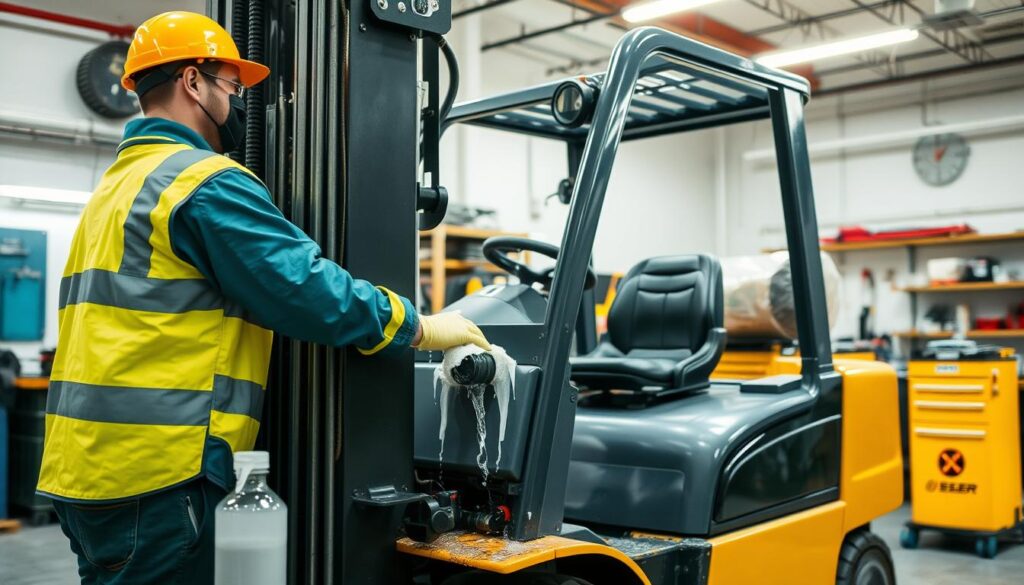
Common Forklift Battery Issues
Proactively identifying common forklift battery issues, such as battery sulfation and overheating, is crucial for maintaining optimal performance. As industrial batteries age, particularly those over five years old, they often face problems that can significantly affect their efficiency and longevity21. Understanding these challenges enables you to take preventive measures, ensuring your forklift operates smoothly.
Understanding Battery Sulfation
Battery sulfation occurs when lead sulfate crystals build up on the battery plates, hindering its capacity and decreasing its lifespan. This issue is particularly prevalent in batteries that have been improperly charged or left in a discharged state for too long. Industrial battery sulfation can also lead to loss of cranking power and longer charging times22. To combat this, regular equalizing and timely recharging when batteries drop to the 20-30% range can help maintain optimal performance.
Dealing with Overheating
Overheating forklift batteries can pose serious risks, including potential failure. This problem often arises from insufficient cooling or exposure to high ambient temperatures. Corroded or damaged terminals can further exacerbate the situation by impairing charging and limiting power transfer22. Proper ventilation and consistent temperature monitoring are essential to manage the risk of overheating. Remember, a battery subjected to opportunity charging while at 70% can shorten its useful life22.
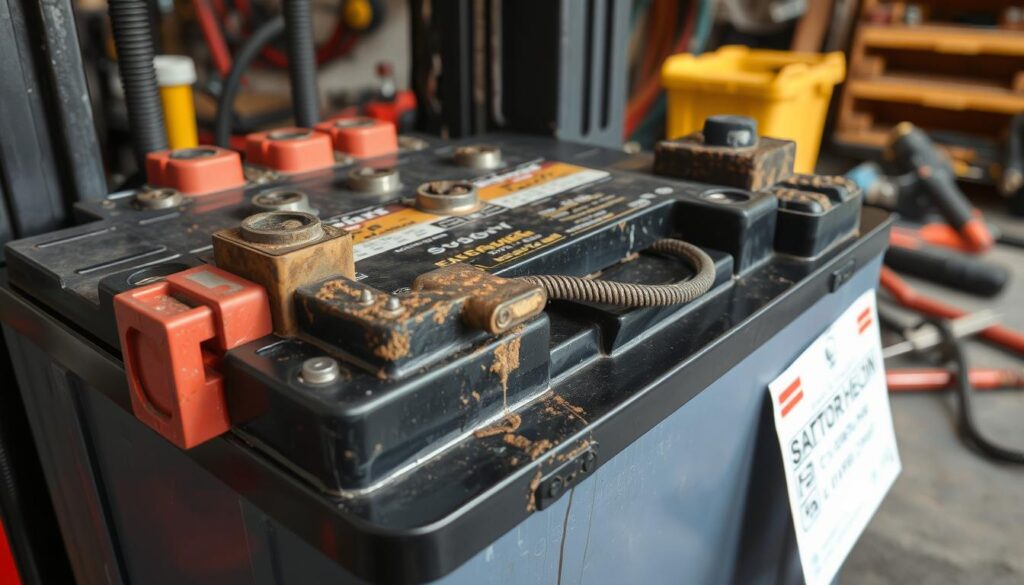
Warranty and Lifespan Considerations
Understanding warranty for forklift batteries and their lifespan is crucial for effective management of your equipment. A comprehensive battery warranty protects your investment and often outlines what battery warranty covers, allowing you to know what issues are eligible for support. The lifespan of forklift batteries typically ranges from 5 to 7 years, depending on the type and maintenance practices.
What Your Warranty Covers
When investing in a forklift battery, reviewing the warranty details is essential. Warranties generally cover defects in materials and workmanship, but may also require adherence to specific maintenance schedules. For lithium-ion batteries, minimal upkeep is mandatory due to sensitivity to high temperatures and overcharging risks23. AGM batteries require less maintenance compared to lead-acid batteries while providing quicker charging capabilities23. It’s important to follow the maintenance guidelines stipulated in your warranty to avoid voiding coverage.
Average Lifespan of Forklift Batteries
The average lifespan of forklift batteries, particularly lead-acid types, necessitates regular checks. They usually last between 5 to 7 years if maintained well24. Essential routine tasks include checking electrolyte levels weekly and ensuring connections are clean and free from corrosion23. Additionally, electric forklift batteries should never discharge below 20% to prevent damage and maximize longevity24. Engaging in regular maintenance service can significantly extend battery life and help you capitalize on warranty benefits, ensuring your operations remain efficient.
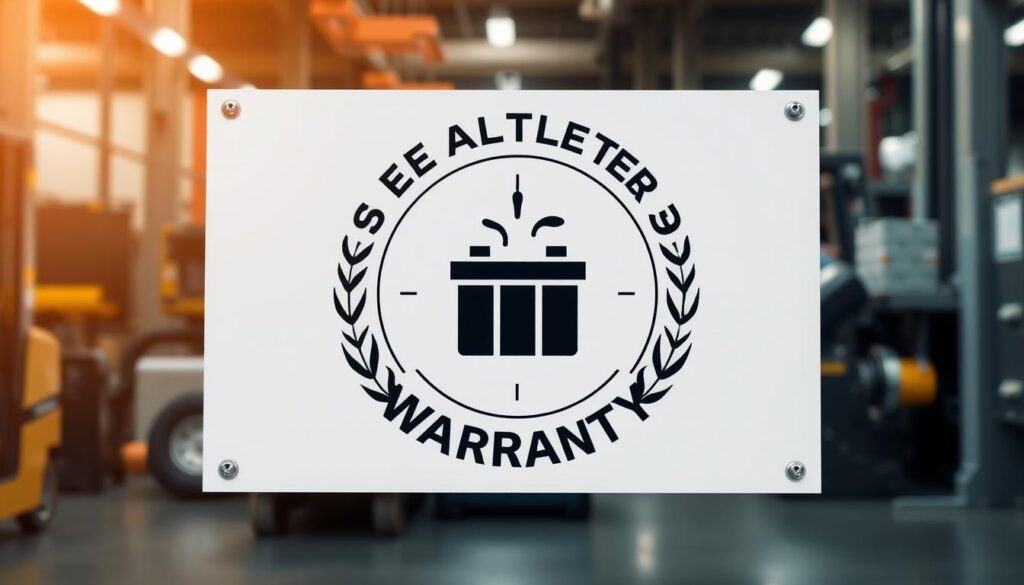
When to Seek Professional Help
Recognizing the right time to seek professional help for batteries can aid in maintaining the efficiency and lifespan of your forklift. Often, certain issues can escalate if not addressed promptly, making it important to be proactive in identifying battery problems. Complex situations may involve significant damage, such as severe sulfation, frequent charging difficulties, or notable physical wear.
Identifying Complex Problems
While simple maintenance can be handled in-house, identifying battery problems that signal a need for expert assistance is crucial. Signs of potential failure include:
- Difficulty in achieving a full charge
- Foul odors or leaks from the battery casing
- Consistent drops in operational performance
- Noticeable swelling or cracking on the battery
If you encounter these symptoms, it’s advisable to consider seeking professional help for batteries to prevent further damage or unsafe conditions.
Choosing the Right Battery Service Provider
Selecting a reliable battery service provider is equally important. When making your choice, focus on:
- Expertise in your specific battery type, such as lead-acid or lithium-ion
- Positive customer reviews and references
- Commitment to safety standards during servicing
- Availability of comprehensive services, including repairs and replacements
Doing your homework enables you to choose a capable battery service provider, ensuring your forklift batteries are managed effectively and safely. Keeping your equipment in prime condition can help maximize its uptime and productivity, while minimizing future repair costs. Trust expert intervention, especially when identifying complex problems becomes challenging.
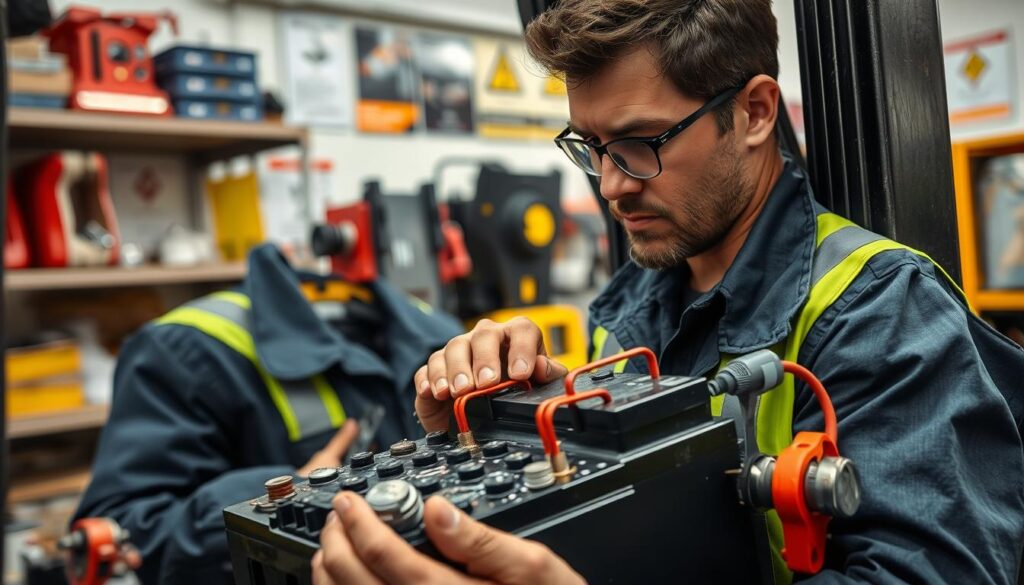
Conclusion: Keeping Your Forklift Batteries Healthy
Maintaining the health of your forklift batteries is essential for ensuring efficient and safe operations. By adopting effective strategies such as regular inspections, proper charging techniques, and timely reconditioning, you can significantly enhance the performance and longevity of your forklift batteries. Remember that regular maintenance not only minimizes operational costs but also boosts your equipment’s reliability and lifespan252627.
Recap of Maintenance Tips
A comprehensive maintenance tips recap includes keeping an eye on water levels, cleaning batteries with a baking soda solution, and becoming familiar with signs that indicate your battery needs attention, such as longer charging times or unusual heat during operation2526. Adhering to these recommendations fosters an understanding of what goes into keeping forklift batteries healthy, thereby reducing unexpected downtime and costly repairs.
Benefits of Well-Maintained Batteries
The benefits of battery maintenance extend beyond cost savings; it also encompasses improved workflow efficiency and safety in the workplace2526. Investing time in proper maintenance promotes a sustainable workplace by ensuring that your forklift batteries operate at peak performance, ultimately contributing to a more productive and safer environment.

